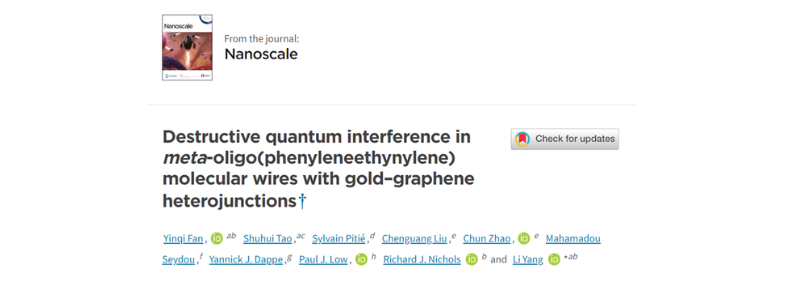06 Mar 2024
Recently, Professor Li Yang’s team of the Department of Chemistry, School of Science, Xi’an jiaotong-Liverpool University published a paper on Nanoscale and has found that the quantum interference effect in oligo(phenyleneethynylene) (OPE) molecular junctions can be modulated by the anchoring groups and the electrode materials used in the construction of molecular junctions. When using ethyne as the anchoring groups and gold-graphene as the electrode system, the difference in conductance between para- and meta-connected OPE molecular junctions can be up to 300 times.

Click here to read the original text
Gordon Moore, one of the founders of Intel Corporation, suggested that the number of transistors in integrated circuits doubles approximately every two years, known as Moore's Law. With the advancement of electronic technology, the size of electronic components has been greatly reduced. Although Moore's Law has not yet reached its limit, the miniaturization of electronic components is gradually slowing down. As a new direction for further miniaturization of electronic devices, molecular electronics have great potential application value for developing new computers, sensors and electronic devices.

Quantum interference is recognized as an important factor of molecular junction conductance. Many structure-property relationship studies have shown that the conductance of para-connected OPE molecular junctions is affected by constructive quantum interference (CQI) effect. In contrast, the conductance of meta-connected OPE molecular junctions is affected by destructive quantum interference (DQI) effect. Currently, most studies of the electron transport in molecular junctions have focused on molecular junctions with symmetric structures. The asymmetric effects on the conductance of molecular junctions has rarely been investigated. The team’s researchers led by Professor Li Yang designed a series of molecular junctions with different anchoring groups and electrode systems. And they studied the electron transport in molecular junctions and the modulation of the quantum interference effect through experiments and theoretical calculations.

Researchers discover new electron transport mechanism in electronics
Their study found that the conductance of all meta-connected OPE molecules exhibited low conductance values due to DQI effect, which is mainly caused by the poor coupling between the electrode and the anchoring group. When the electrode was changed from the Au-Au symmetric system to the Au-graphene asymmetric system, for amine-anchored OPE, the electron transport was not affected by the electrode materials change. For the methyl sulfide- and ethynyl-anchored OPEs, the gold-graphene asymmetric electrode system significantly affects the appears of DQI in OPEs. The ethynyl-anchored OPEs showed the most difference in conductance.

The results of this study emphasize the important role of electrode materials and anchoring groups in regulating the appears of the DQI effects. The researchers hope this study will provide more design space and theoretical basis for future molecular device design and optimization.
Content provided:Professor Li Yang
06 Mar 2024







